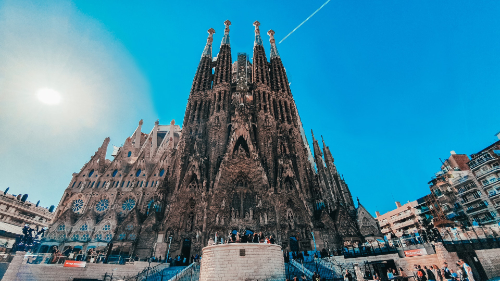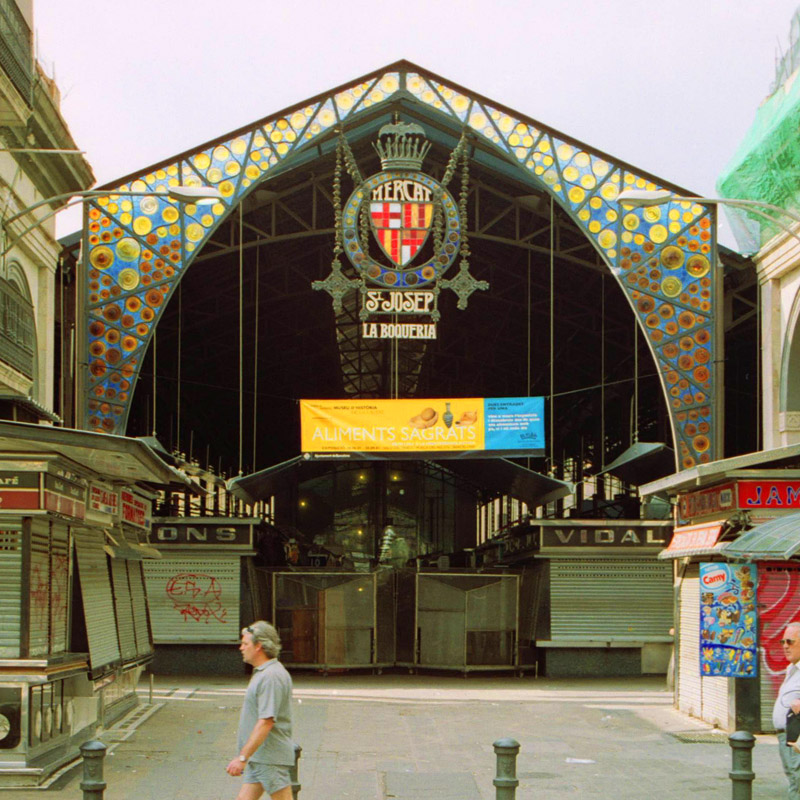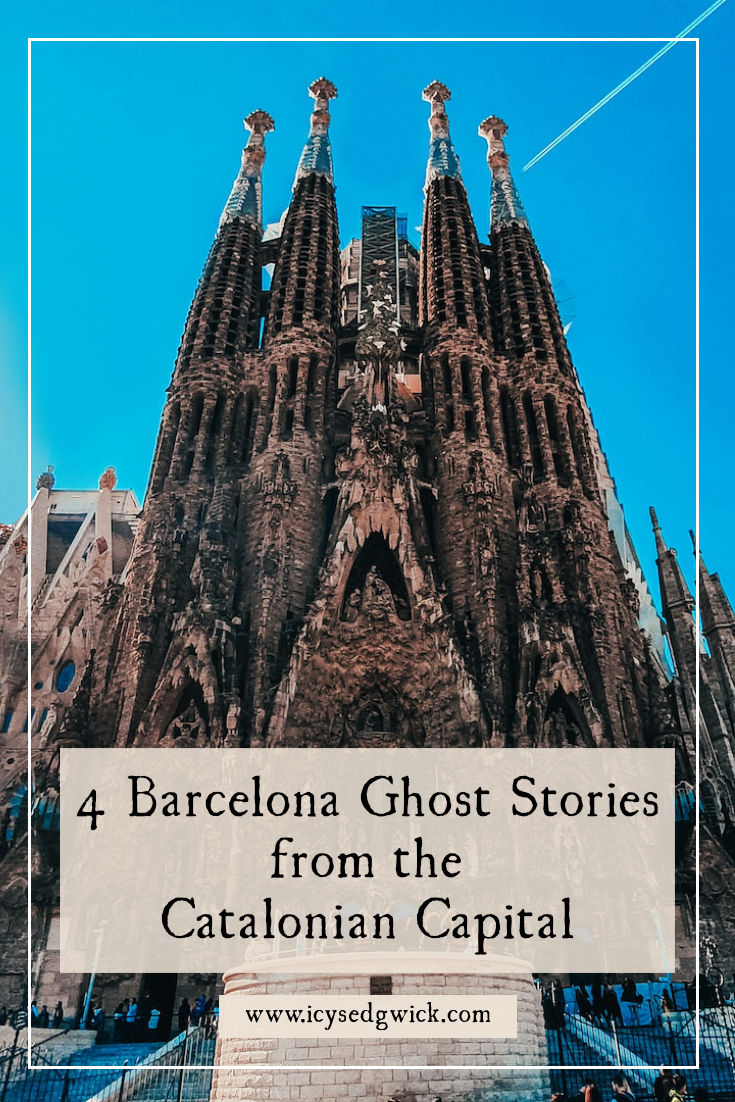Barcelona lies on the Mediterranean Coast in Catalonia. It’s a gorgeous city, famous for architect Antoni Gaudí, artist Joan Miró and writer Carlos Ruiz Zafón, among many others. Yet you’ll find more than a few Barcelona ghost stories amid the winding streets and Gothic cathedrals.
Strange histories abound in Barcelona. Astruc Sacanera, an astrologer and sorcerer, was said to live in the Carrer d’Estruc during the 15th century. According to legend, he was a psychic and made predictions about the future based on people’s private thoughts. He also claimed to be a healer, using a dark-coloured stone and mysterious powders to cure bites and rabies.

In 1892, an industrialist apparently sold his soul to the devil in order to become rich. When he won the lottery, he celebrated by decorating his house at Carrer Josep Torres 20 with demon heads.
And travellers would disappear if they stayed in the inns along Carrer de la Flor de Lliri. This, my friends, is just scratching the surface! So in this article, we’ll look at four Barcelona ghost stories of vengeful monks, sad spectres, and even a poltergeist…
1. La Boqueria Market
The famous Boqueria Market on La Rambla stands on the site of a monastery for the Barefoot Carmelites of St Joseph. By 1835, the monks’ lifestyle was apparently less regimented than it should have been. So much so that they’d decided not to pray on their saint’s day, Our Lady of Mount Carmel. One young monk was horrified by the decision, still taking his religious orders seriously.
The following night, on July 15, Our Lady of Carmen’s Eve, a strange sound woke the sleeping monks. They followed the sound to its source in the church, where they found a choir of skeleton monks. Their unholy hymns sounded like music not of this earth, but the monks didn’t know what to do. Should they interrupt them?

They decided to let the skeletal choir finish. Once the music died away, the living monks lit candles and led the ghosts back to their tombs. When they got back to the cemetery, they found all the tombs standing open and empty. Each skeletal monk climbed back into his tomb and they closed behind them.
Still baffled as to what had prompted such a performance, some of the monks returned to the church to see if there were any clues. Instead, they found the body of the devout young monk on the exact spot where the ghostly choir sang. Ten days later, a fire destroyed the monastery, killing the monks. According to legend, people still hear ghostly singing and footsteps around the market on July 25th.
Was the fire ghostly retribution for the actions of the lapsed monks? Possibly. That said, the Boqueria Market website points out that riots broke out on the Feast Day of St James, and fire destroyed the Carmelite Convent after this.
2. Gran Liceu Opera House
Looks like Paris isn’t the only city with ghosts associated with an opera house. Barcelona boasts the Gran Teatre del Liceu on La Rambla, just over 200m away from the Boqueria Market.
Like the market, it stands on the site of a monastery, this time the Convent of the Trinitarians. In 1835, the convent burned down during a riot and sadly, one of the monks perished.
In 1847, the Gran Teatre del Liceu, the Barcelona Opera House, was built on the site. The theatre hosted various forms of entertainment in its ballroom, as well as opera and ballet.

People began reporting the appearance of a ghostly monk during parties, especially those with more pagan themes. He accused partygoers of starting the fire that gutted the monastery. According to the legend, in 1861, a fire destroyed the theatre. The police found a note in the ruins threatening to burn the theatre again if anyone rebuilt it.
No one took the threat seriously, and building work on a new theatre began. Flooding held up the construction and people began to whisper that the site was cursed. The theatre managed to reopen a year later, but in 1893, an anarchist bombed the theatre and killed twenty people.
In 1994, fire once more consumed the building. It seems a spark hit the main curtain in the theatre during repair work. The theatre was rebuilt, having been expanded to occupy a larger site, but still boasting a faithful exterior to the previous one.
Some have wondered if another fire will strike. Is it the monk, out for revenge for the destruction of his monastery? Or is it the fact the site was used for executions in the Middle Ages? Some said one of those scheduled to die there cursed the place, and this curse may have soaked into the very earth itself. Strangely, the opera house’s website doesn’t mention the 1861 fire in its history of the building.
3. Rocafort Metro Station
Building work began on the metro system in 1924. Like underground systems elsewhere, including the London Underground, it has its fair share of ghost stations.
And it also has ghosts in the stations. Built in 1968 but never opened, you can sometimes see the platforms of the Gaudí station. Look out for them on Line 5 between Sagrada Familia and Sant Pau/Dos de Maig. People say they’ve seen people waiting for a train on the unused platforms.
Rocafort is perhaps the most famous haunted station, one that workers hate being sent to. Staff sometimes see people wandering along the platforms on CCTV, but only after the station has closed. If staff go to explain the trains have stopped running for the night, the platforms are empty.

It certainly seems to have earned its cursed reputation. During the Civil War, the space provided refuge before it became part of the network. A mudslide during its construction killed eleven workers.
It has the highest number of suicides on the subway network and suffered four suicides in one month during the 1970s. A child playing with a ball fell on the tracks and was hit by a train. A medium once claimed to see a child on the platform playing with a ball.
4. The Poltergeist at 43 Francisco Giner Street
The events at 43 Francisco Giner Street make it Barcelona’s most famous haunted house. It’s also considered to be the location of Catalonia’s first documented poltergeist case.
Let’s zoom in to the evening of 10 February 1935. The Montroig i Mendoza family sleep in their apartment while the family patriarch works the night shift. Loud noises wake the family, and the oldest son hauls himself out of bed to check the apartment is secure.

As he moves around the apartment, the cabinet drawers shoot open and fall to the floor with a crash. This wakes up the neighbours, who call the night watchman. He helps the family search the apartment, but no one can find the source of the noises. They suddenly stop, with silence filling the apartment. Satisfied everything is now as it should be, everyone goes back to bed… at which point they start up again.
The noises are still going by the time Mr Montroig gets home from work. Confused and disturbed by his family’s reports, he fetches the police. Like the night watchman, they search the apartment, but they can’t find the source either.
Everyone holds their breath the following evening, fearful of another disturbed night. Yet nothing happens and the night passes without incident. Big sigh of relief all round!
The family and the neighbours assume it must have been a one-off and go about their lives as normal. But the following evening? Everything kicks off again and the neighbours come into the apartment. What they see shocks them. Lamps move of their own accord. Chairs levitate when no one stands near them. Cutlery floats through the air. A clock seems to go mad, its hands moving round and round, independent of the time.
It gets worse. White shadows move in empty corridors, and the temperature plummets wherever they’re seen in the building. A sudden hailstorm covers the courtyard with ice.
Still, no one knows what’s going on.
The case ended up receiving media attention. The police had to post guards at the door to keep people away. But the phenomenon continued, only ending when everyone in the building moved out.
To this day, no one knows what was going on in that apartment. Some blamed the Montroig’s teenage son for the activity since he was ill at the time. But no one was able to explain the white shadows or the hailstorm.
Which of these Barcelona ghost stories did you enjoy best?
Barcelona is a beautiful city that’s well worth a visit. But remember these stories when you’re strolling along La Rambla. And keep them in mind if you tour the Camp Nou Stadium.
The city has a dark side…and these Barcelona ghost stories are only just scratching the surface!
Sources
Barcelona Navigator (2023), ‘Haunted and Mysterious Places in Barcelona’, Barcelona Navigator, https://barcelonanavigator.com/haunted-places/.
Bond, Rosalind (2016), ‘Urban Legends’, Barcelona Metropolitan, https://www.barcelona-metropolitan.com/features/urban-legends/.
Fox, Esme (2023), ‘Barcelona’s most haunted places’, Coffee and Caminos, https://coffeeandcaminos.com/travel/europe/barcelonas-most-haunted-places/.
La Boqueria Market (no date), ‘History: Origins 2’, La Boqueria Market, https://www.boqueria.barcelona/history.
Liceu Opera Barcelona (no date), ‘History’, Liceu Opera Barcelona , https://liceubarcelona.cat/en/history.
Marta (2023), ‘Barcelona Hounted Houses, Places and Buildings’, Forever Barcelona, https://www.foreverbarcelona.com/haunted-barcelona-houses-places/.
Nutty about folklore and want more?
Add your email below and get these posts in your inbox every week.
You'll also get my 5-step guide to protecting your home using folklore!








Great article, Icy! There are so many ghost stories in my home city I didn’t know about. In recent years we even have our own ghost guiding tours and gigs. I feel guilty for not talking about this more often, myself. Thanks for creating awareness! 🥰
Next time I’m in Barcelona, I’ll have to do one of the tours!
Loving these episodes! One recommendation, in case you’re planning to continue this series at a later date: have you looked into the ghost stories of Vienna? There are quite a few.
My choices were dictated by which cities I’ve personally visited. Luckily, I have been to Vienna, but I’ll have to save it for the next time I revisit this theme!